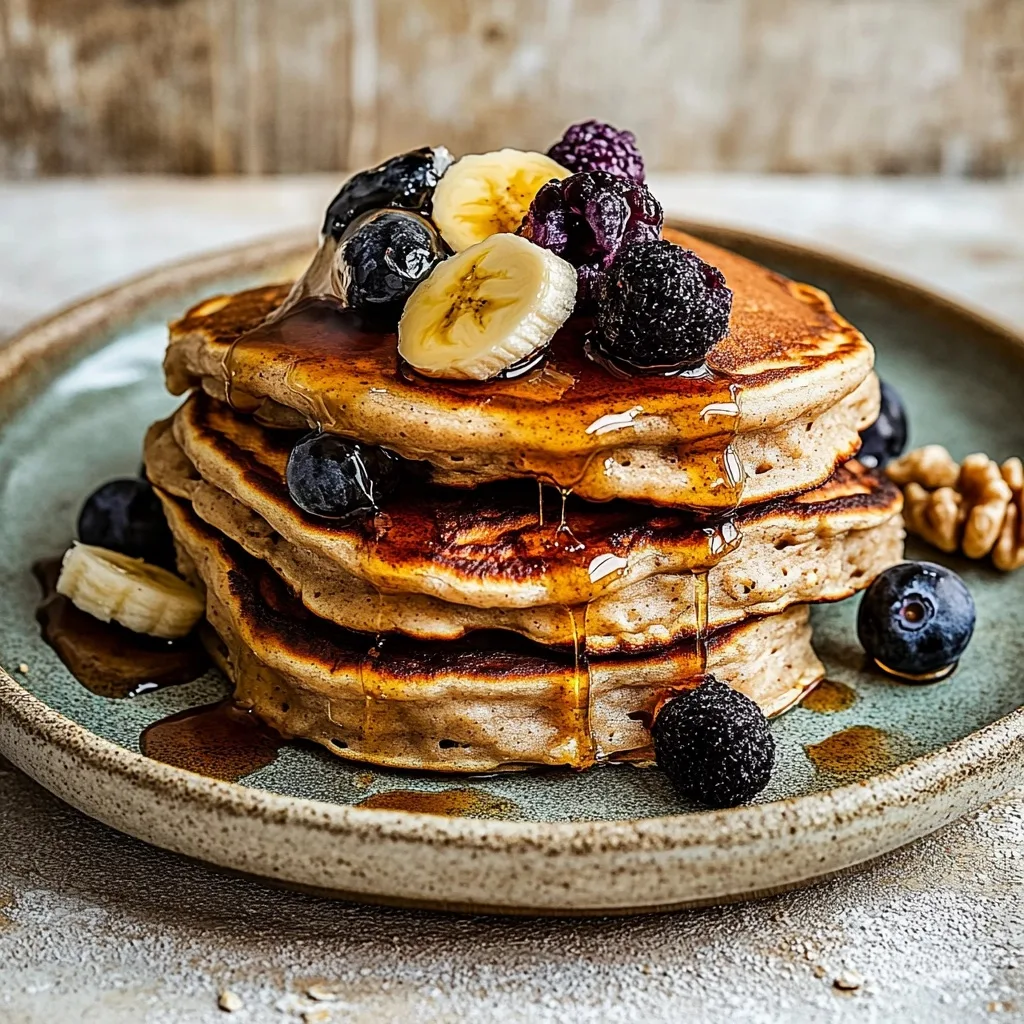Fluffy, filling, and packed with muscle-building nutrients, these protein pancakes transform your ordinary breakfast into a powerhouse meal that supports your fitness goals while satisfying your taste buds.
Introduction: Why Protein Pancakes Are a Game-Changer for Your Morning Routine
Breakfast enthusiasts and fitness lovers alike, rejoice! Protein pancakes have revolutionized the morning meal landscape, offering a delicious solution to the age-old question: “How can I enjoy pancakes without derailing my nutrition goals?” These aren’t your grandmother’s pancakes—they’re the upgraded, nutritionally superior version that delivers all the comfort of traditional flapjacks with the added bonus of muscle-supporting protein.
Protein pancakes have surged in popularity for good reason. Unlike standard pancakes that often leave you hungry an hour later, these protein-packed alternatives provide sustained energy throughout your morning. They combine the satisfying fluffiness we all crave from pancakes with ingredients specifically chosen to support muscle recovery, weight management, and overall health.
Whether you’re a busy parent needing fuel for hectic mornings, an athlete recovering from intense training, or simply someone who wants to start their day with a nutritious yet delicious breakfast, protein pancakes offer the perfect balance. They’re customizable, family-friendly, and surprisingly simple to make—even on those mornings when you’re rushing out the door.
In this comprehensive guide, we’ll explore everything you need to know about creating the perfect protein pancakes, from selecting the right ingredients to mastering cooking techniques and discovering creative variations that will keep your breakfast exciting day after day. Let’s dive into the world of protein pancakes and transform your morning routine forever!
The Science Behind Protein Pancakes: Benefits Beyond Just Taste
Nutritional Powerhouse: What Makes Protein Pancakes Special
Protein pancakes aren’t just delicious—they’re nutritionally strategic. The average serving of protein pancakes (about 3 medium pancakes) contains approximately 20-25 grams of protein, compared to just 5-7 grams in traditional pancakes. This protein difference is crucial for several bodily functions.
When you consume protein in the morning, you’re providing your body with the building blocks it needs for muscle repair and growth, especially important if you exercise regularly. Research has shown that a protein-rich breakfast can help reduce hunger hormones throughout the day, potentially leading to better food choices and reduced overall calorie intake.
Additionally, the combination of protein and complex carbohydrates in these pancakes offers a winning formula for sustained energy release. Unlike simple carbohydrates that cause blood sugar spikes and crashes, the protein-carb duo in these pancakes helps maintain stable blood glucose levels, keeping you energized and focused throughout your morning.
Perfect Post-Workout Meal: Timing Your Protein Pancakes
For fitness enthusiasts, protein pancakes serve as an ideal post-workout meal. After exercise, your muscles are particularly receptive to nutrients, entering what nutritionists call the “anabolic window.” Consuming protein within this window (typically within 30-60 minutes after exercise) helps maximize muscle protein synthesis.
The protein in these pancakes provides essential amino acids that support muscle recovery, while the carbohydrates help replenish glycogen stores that were depleted during your workout. This combination makes protein pancakes not just a breakfast option, but a strategic recovery meal any time of day.
Moreover, the versatility of protein pancakes means you can adjust the recipe to match your specific fitness goals, whether you’re focused on building muscle, losing weight, or maintaining your current physique.
Essential Ingredients: Building the Perfect Protein Pancake
The Foundation: Protein Sources and Their Benefits
The star ingredient in protein pancakes is, unsurprisingly, protein. However, not all protein sources are created equal. Here’s a breakdown of common protein options and their unique benefits:
Protein Powder: The most common addition to protein pancakes, offering 20-25 grams of protein per scoop. Whey protein creates the fluffiest texture and is quickly absorbed, making it ideal for muscle recovery. Plant-based alternatives like pea, hemp, or brown rice protein work well for those avoiding dairy, though they may produce slightly denser pancakes.
Eggs: Beyond binding the ingredients together, eggs contribute high-quality complete protein (about 6 grams per egg) and essential nutrients like choline, which supports brain health. The whites provide protein without fat, while the yolks add valuable vitamins and minerals.
Greek Yogurt: Adding 1/4 cup of Greek yogurt can boost protein content by 5-7 grams while creating a tender texture. It also contributes probiotics for gut health and calcium for bone strength.
Cottage Cheese: With about 13 grams of protein per 1/2 cup, cottage cheese creates an exceptionally moist pancake while providing slow-digesting casein protein that offers sustained amino acid release.
Carbohydrate Components: Energy Sources That Complement Protein
Carbohydrates in protein pancakes aren’t just fillers—they provide energy and affect the pancakes’ texture and flavor:
Oats: Ground into flour, oats provide fiber-rich complex carbohydrates that digest slowly, preventing blood sugar spikes. They create hearty, satisfying pancakes with a slightly nutty flavor.
Bananas: Beyond natural sweetness, ripe bananas add potassium (essential for muscle function), fiber, and moisture that helps bind ingredients together without extra fats.
Alternative Flours: Almond, coconut, or quinoa flours can replace traditional options, each offering unique nutritional benefits and flavors. Almond flour adds healthy fats and vitamin E, while coconut flour is extremely fiber-rich but requires more liquid in the recipe.
Flavor Enhancers and Nutritional Boosters
The right additions can transform basic protein pancakes into extraordinary breakfast experiences:
Spices: Cinnamon not only adds warmth but may help regulate blood sugar. Nutmeg, cardamom, or pumpkin pie spice create seasonal variations.
Extracts: Vanilla extract enhances sweetness perception without adding sugar. Almond, coconut, or maple extracts can create distinctive flavor profiles.
Hidden Vegetables: Grated zucchini, carrots, or pumpkin puree add moisture, nutrients, and fiber while remaining virtually undetectable in the finished pancakes.
Seeds: A tablespoon of flaxseed, chia seeds, or hemp hearts boosts omega-3 fatty acids, fiber, and additional protein with minimal impact on flavor.
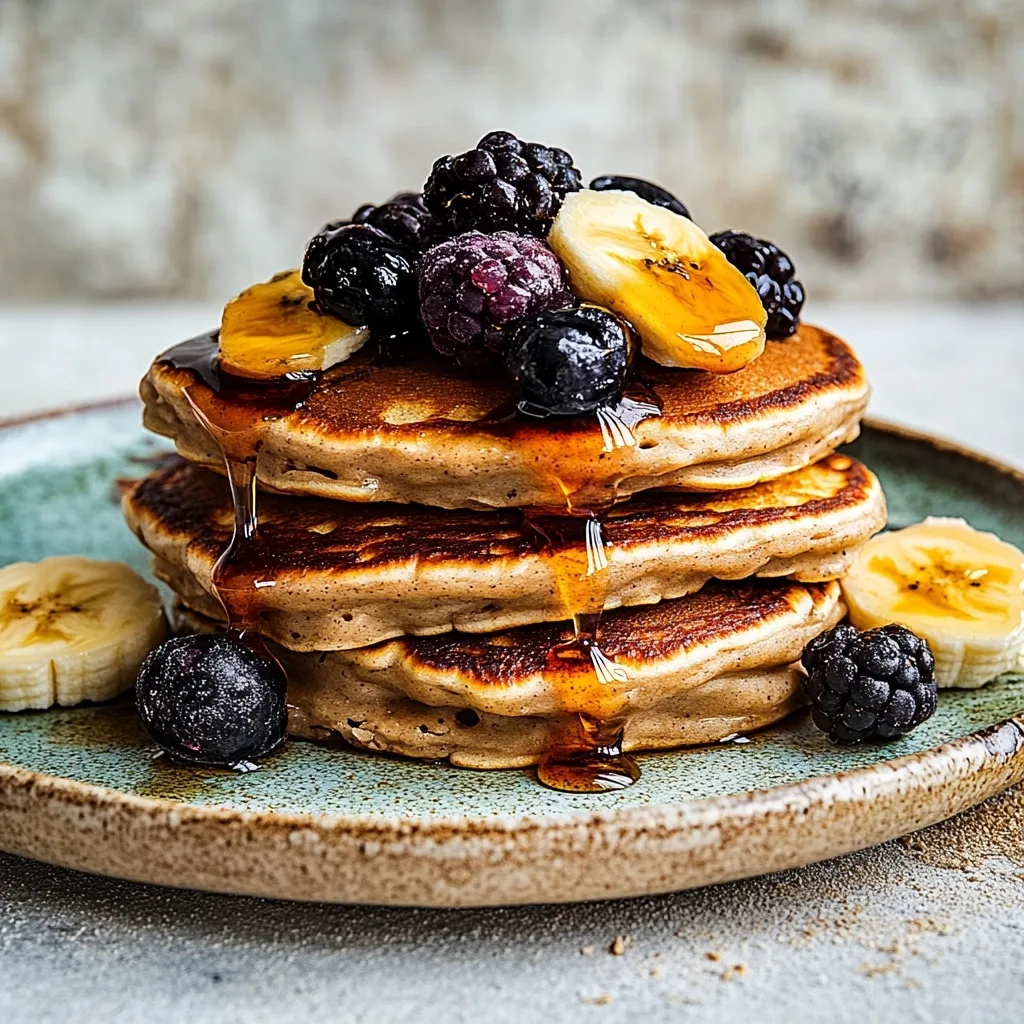
Step-by-Step Guide to Perfect Protein Pancakes
Mastering the Basic Recipe
Creating perfect protein pancakes starts with understanding the fundamental recipe. Here’s our tried-and-true method that produces consistently delicious results:
Ingredients:
- 1 cup old-fashioned rolled oats
- 1 scoop (about 30g) vanilla or unflavored protein powder
- 1 ripe banana, mashed
- 2 large eggs
- 1/2 cup low-fat milk (dairy or plant-based)
- 1 teaspoon baking powder
- 1/2 teaspoon ground cinnamon
- Pinch of salt
- 1 teaspoon pure vanilla extract
- Cooking spray or butter for the griddle
Method:
- Create Your Flour Base: Pulse the oats in a blender until they reach a flour-like consistency. This creates a smoother pancake texture while maintaining the nutritional benefits of whole oats.
- Combine Dry Ingredients: Add the protein powder, baking powder, cinnamon, and salt to the blender with the oat flour.
- Incorporate Wet Ingredients: Add the mashed banana, eggs, milk, and vanilla extract. Blend until just combined, about 20-30 seconds. Avoid over-blending, which can make pancakes tough.
- Rest the Batter: Allow the batter to rest for 5-10 minutes. This gives the oats time to absorb liquid and the baking powder time to activate, resulting in fluffier pancakes.
- Prepare Your Cooking Surface: Heat a non-stick griddle or skillet to medium heat. When a few drops of water “dance” on the surface, it’s ready. Apply a light coating of cooking spray or butter.
- Cook with Patience: Pour 1/4 cup portions of batter onto the heated surface. Wait until bubbles form on the top and the edges appear set (about 2-3 minutes) before flipping. The second side will cook faster, typically 1-2 minutes.
- Keep Warm: If cooking for a crowd, keep finished pancakes warm in a 200°F oven on a wire rack (to prevent sogginess) until ready to serve.
Troubleshooting Common Issues
Even experienced cooks encounter challenges with protein pancakes. Here are solutions to common problems:
Pancakes Too Dense: This often results from too much protein powder or insufficient leavening. Try reducing protein powder by 1 tablespoon and increasing baking powder to 1 1/2 teaspoons.
Batter Too Thick: Add 1-2 tablespoons of milk at a time until you reach a pourable consistency that still holds its shape on the griddle.
Pancakes Falling Apart: Usually caused by insufficient binding. Add an extra egg white or 1 tablespoon of ground flaxseed mixed with 3 tablespoons of water (a “flax egg”).
Burning Before Cooking Through: Your heat is too high. Lower the temperature and extend cooking time, or cover the pan briefly to help the centers cook through.
Sticking to the Pan: Either your pan isn’t hot enough before adding batter, or it needs more greasing. Make sure the pan is properly preheated and apply a fresh coat of cooking spray between batches.
Creative Variations: Taking Your Protein Pancakes to the Next Level
Flavor Inspirations from Around the World
The basic protein pancake recipe serves as an excellent canvas for creative flavor combinations:
Blueberry Lemon: Add 1/2 cup fresh blueberries and 1 teaspoon lemon zest to the batter. Top with additional blueberries and a dollop of lemon-infused Greek yogurt.
Apple Cinnamon: Fold 1/2 cup diced apple and an extra 1/2 teaspoon cinnamon into the batter. Top with warm cinnamon-spiced apple compote for a fall-inspired breakfast.
Chocolate Protein Pancakes: Use chocolate protein powder and add 1 tablespoon of unsweetened cocoa powder to the batter. Top with sliced strawberries and a small drizzle of melted dark chocolate for an indulgent-tasting but still nutritious breakfast.
Pumpkin Spice: Replace the banana with 1/3 cup pumpkin puree and add 1 teaspoon of pumpkin pie spice. Top with chopped pecans and a dollop of cinnamon-spiced Greek yogurt.
Tropical Twist: Add 2 tablespoons of unsweetened shredded coconut and 1/4 cup diced pineapple to the batter. Top with additional fresh pineapple and a sprinkle of toasted coconut.
Seasonal Adaptations
Adjust your protein pancakes throughout the year to celebrate seasonal ingredients:
Spring: Incorporate fresh berries and lemon zest, topped with a light berry compote.
Summer: Add peaches or nectarines to the batter and top with fresh stone fruits and a sprinkle of cinnamon.
Fall: Embrace warming spices like cinnamon, nutmeg, and cloves, with apple or pumpkin mix-ins.
Winter: Create festive pancakes with cranberries, orange zest, and a touch of allspice or cardamom.
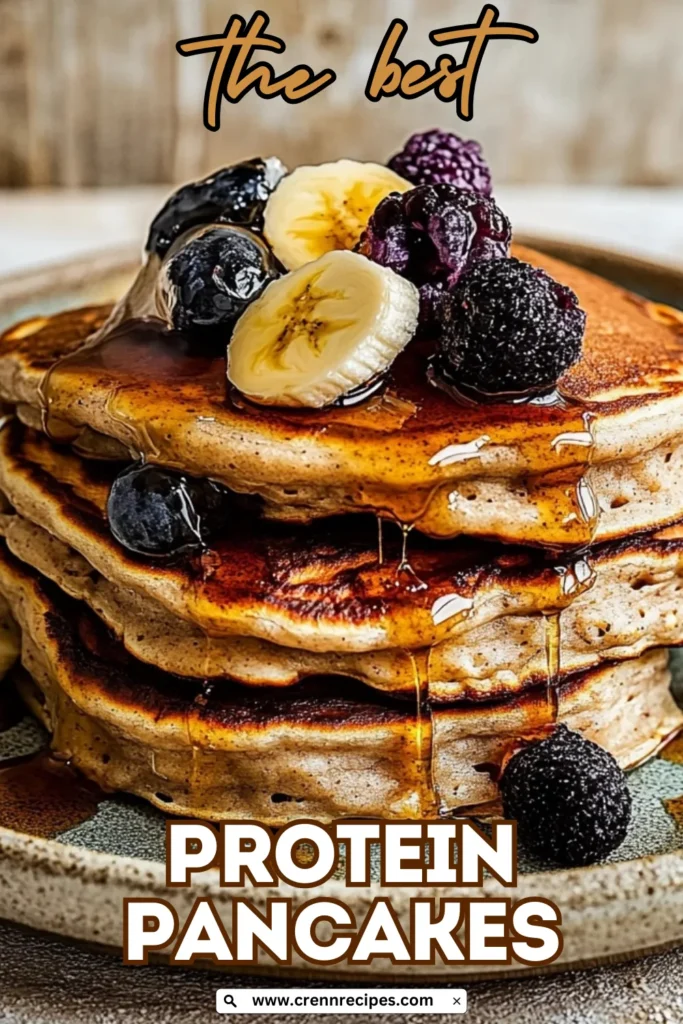
Toppings and Accompaniments: Elevating Your Protein Pancake Experience
Nutritious Topping Ideas Beyond Maple Syrup
While pure maple syrup is delicious, consider these nutritionally superior alternatives:
Fruit-Based Toppings:
- Fresh berry compote (heat 1 cup berries with 1 tablespoon water until soft)
- Sliced banana with a sprinkle of cinnamon
- Diced apple sautéed with cinnamon and a touch of coconut oil
- Warm peach or pear compote with a hint of ginger
Protein-Rich Options:
- Greek yogurt swirled with a touch of honey
- Cottage cheese mixed with cinnamon and vanilla
- Nut butter drizzle (almond, cashew, or natural peanut butter)
- Ricotta cheese with lemon zest and a touch of honey
Crunchy Elements:
- Toasted chopped nuts (walnuts, almonds, pecans)
- Roasted pumpkin or sunflower seeds
- Low-sugar granola sprinkle
- Toasted coconut flakes
Creating a Complete Breakfast
Pair your protein pancakes with complementary sides for a nutritionally balanced meal:
Fresh fruit salad: Provides additional vitamins, minerals, and fiber.
Scrambled egg whites: Adds extra protein without significant additional calories.
Vegetable-fruit smoothie: Contributes hydration and micronutrients that complement the protein-rich pancakes.
Turkey bacon: Offers a savory contrast with additional protein and less fat than traditional bacon.
Meal Prep Strategies: Protein Pancakes for Busy Lifestyles
Make-Ahead Methods That Preserve Quality
Protein pancakes are ideal for busy mornings when prepared in advance:
Refrigerated Storage: Cooked pancakes will stay fresh in an airtight container for 3-4 days. Separate layers with parchment paper to prevent sticking.
Freezer Techniques: Place cooled pancakes in a single layer on a baking sheet until frozen solid (about 2 hours), then transfer to freezer bags. This prevents them from freezing together. They’ll keep for up to 3 months.
Reheating for Best Texture: Microwave refrigerated pancakes for 20-30 seconds or frozen ones for 60-90 seconds. For crispier edges, use a toaster oven or air fryer for 2-3 minutes. Avoid standard toasters which may break delicate protein pancakes.
Dry Mix Preparation: Create your own protein pancake mix by combining the dry ingredients in batches. Store in airtight containers for up to 3 months, then just add the wet ingredients when ready to cook.
On-the-Go Protein Pancake Ideas
Protein pancakes can be adapted for portable enjoyment:
Pancake Sandwiches: Spread nut butter between two small pancakes for a high-protein handheld breakfast.
Pancake Dippers: Make silver-dollar sized pancakes perfect for dipping into individual containers of yogurt or applesauce.
Pancake Muffins: Pour the batter into a greased muffin tin, bake at 350°F for 15-18 minutes, and enjoy portable, portion-controlled pancake bites.
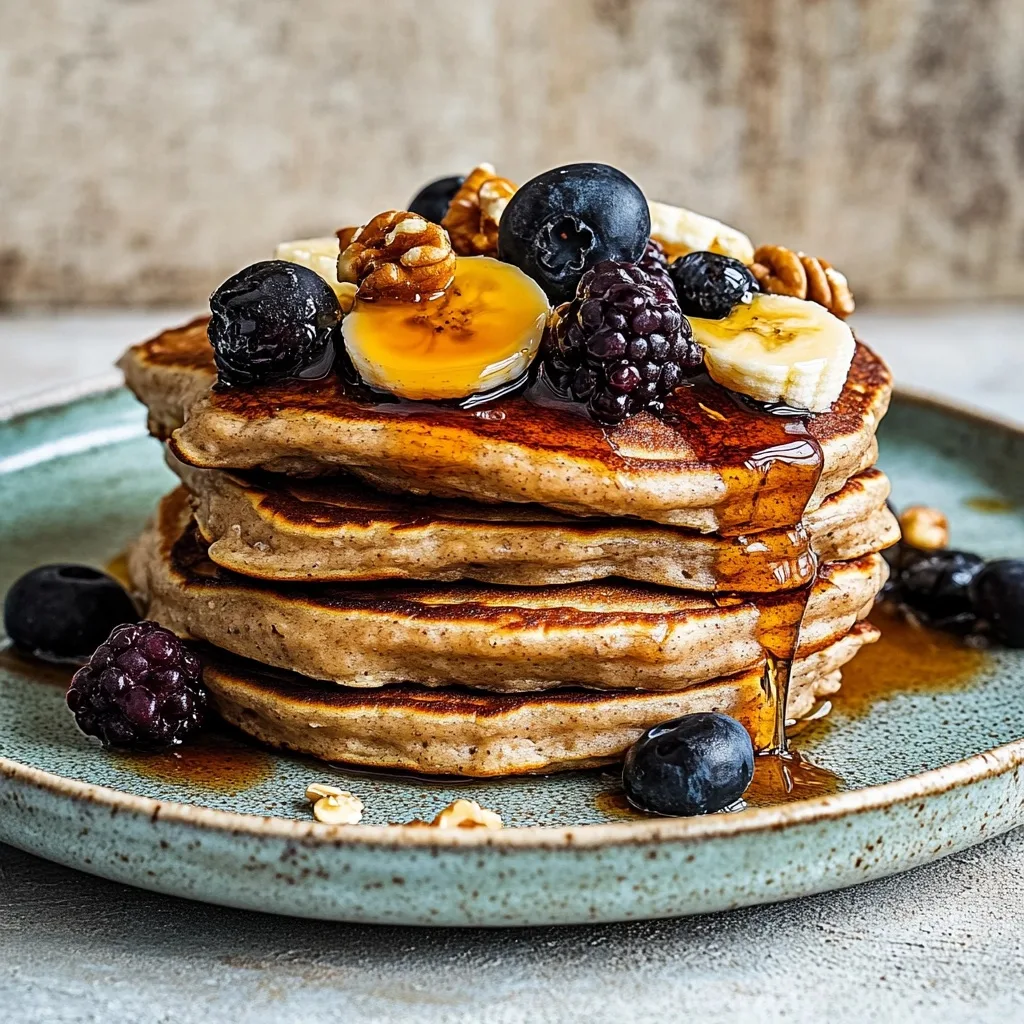
Protein Pancakes for Different Dietary Needs and Goals
Adaptations for Special Diets
Protein pancakes can be modified to accommodate various dietary restrictions:
Gluten-Free: Use certified gluten-free oats or replace oats with almond flour, coconut flour, or a gluten-free flour blend. Ensure your protein powder is also gluten-free certified.
Dairy-Free: Substitute plant-based milk and dairy-free protein powder. Replace Greek yogurt with coconut yogurt if used in the recipe.
Vegan: Use plant-based protein powder, replace eggs with flax or chia eggs (1 tablespoon ground flax or chia seeds mixed with 3 tablespoons water per egg), and choose plant-based milk.
Keto-Friendly: Replace banana with pumpkin puree, use almond flour instead of oats, add an extra egg, and sweeten with stevia or monk fruit sweetener.
Paleo: Use almond flour, coconut flour, or cassava flour instead of oats, choose a paleo-friendly protein powder (egg white or beef protein), and sweeten with honey or maple syrup.
Adjusting for Fitness Goals
Tailor your protein pancakes to support specific fitness objectives:
Muscle Building: Increase protein powder to 1.5 scoops and add 1 tablespoon of nut butter to the batter for additional calories and healthy fats.
Weight Management: Keep portions controlled (2-3 medium pancakes), focus on high-protein toppings like Greek yogurt rather than calorie-dense syrups, and incorporate fiber-rich berries.
Endurance Training: Add 1/4 cup rolled oats (not ground) to the batter for additional slow-release carbohydrates, and top with banana and a small amount of honey for readily available energy.
Recovery Focus: Include anti-inflammatory ingredients like blueberries, tart cherries, or ground turmeric (1/4 teaspoon) in the batter, and top with additional antioxidant-rich fruits.
Frequently Asked Questions About Protein Pancakes
Common Questions and Expert Answers
Q: Why do my protein pancakes turn out rubbery? A: This typically happens when there’s too much protein powder or when the batter is overmixed. Try reducing the protein powder slightly and mix just until ingredients are combined.
Q: Can I make protein pancakes without protein powder? A: Absolutely! Increase the eggs to 3, add 1/4 cup Greek yogurt, and include 2 tablespoons of ground flaxseeds or chia seeds to boost protein content naturally.
Q: Are protein pancakes good for weight loss? A: They can support weight management because their high protein content increases satiety, potentially reducing overall calorie intake throughout the day. Focus on portion control and choose lower-calorie toppings.
Q: How can I increase the fiber content in protein pancakes? A: Add 1-2 tablespoons of ground flaxseed, chia seeds, or psyllium husk, or include grated zucchini or carrots. Using oat fiber or adding a tablespoon of coconut flour also substantially increases fiber.
Q: My pancakes always stick to the pan. What am I doing wrong? A: Ensure your pan is properly preheated before adding batter, use sufficient cooking spray or butter, and check that your non-stick surface isn’t damaged. A good quality non-stick pan makes a significant difference.
Conclusion: Making Protein Pancakes a Regular Part of Your Healthy Lifestyle
Protein pancakes represent the perfect marriage of nutrition and indulgence, proving that health-conscious eating doesn’t require sacrificing the foods you love. By incorporating these nutrient-dense pancakes into your regular meal rotation, you’re not only supporting your physical health but also satisfying that universal craving for comfortable, familiar breakfast foods.
The versatility of protein pancakes makes them appropriate for virtually any lifestyle—from busy professionals needing quick, nutritious breakfasts to athletes requiring strategic pre- or post-workout nutrition, to families seeking kid-friendly recipes that secretly pack in extra nutrients. The ability to customize flavors, adapt to dietary restrictions, and prepare in advance makes protein pancakes a practical solution for modern, health-conscious living.
Remember that sustainable nutrition habits are those you can maintain long-term, and protein pancakes offer that rare combination of health benefits without the feeling of deprivation that dooms many diet changes. By mastering the basic technique and then exploring the endless variations possible, you’ll never grow tired of this nutritional powerhouse breakfast.
Whether you’re flipping these pancakes on a leisurely Sunday morning or grabbing a pre-made stack from the refrigerator on your way out the door, you’re making a choice that supports your health goals while delighting your taste buds. That’s the true secret to lasting healthy habits—finding the sweet spot where nutrition and pleasure converge.
More Related Recipes You Might Enjoy
If you loved these protein pancakes, you’ll definitely want to try these other nutritious breakfast options that provide similar benefits:
- Berry Bliss Smoothie Bowl – Another protein-rich breakfast featuring similar ingredients like fresh berries and versatile toppings.
- Acai Bowl Recipe – Packed with antioxidants and customizable toppings, perfect for those who enjoy fruit-forward breakfast options.
- Classic Vanilla Berry Chia Pudding – A make-ahead breakfast option that delivers protein, fiber, and omega-3 fatty acids.
Each of these recipes shares the protein pancakes’ philosophy of combining nutrition with delicious flavors, making healthy eating an enjoyable, sustainable lifestyle choice rather than a chore.
Print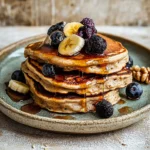
Protein Pancakes: 7 Essential Secrets for Amazing Breakfast Magic
- Total Time: 25 minutes
- Yield: 8 pancakes (4 servings) 1x
- Diet: Low Calorie
Description
Fluffy, filling, and packed with muscle-building nutrients, these protein pancakes transform your ordinary breakfast into a powerhouse meal that supports your fitness goals while satisfying your taste buds. Perfect for a post-workout meal or energizing breakfast, these pancakes deliver sustained energy throughout your morning.
Ingredients
- 1 cup old-fashioned rolled oats
- 1 scoop (about 30g) vanilla or unflavored protein powder
- 1 ripe banana, mashed
- 2 large eggs
- ½ cup low-fat milk (dairy or your favorite plant-based milk)
- 1 teaspoon baking powder
- ½ teaspoon ground cinnamon
- Pinch of salt
- 1 teaspoon pure vanilla extract
- Cooking spray or a pat of butter, for the griddle
Instructions
- In a blender, pulse the oats until they reach a fine, flour-like consistency.
- Add the protein powder, mashed banana, eggs, milk, baking powder, cinnamon, salt, and vanilla. Blend until you’ve got a smooth batter that’s pourable but still has a little body.
- Warm your griddle or non-stick skillet over medium heat. Once hot, lightly coat with cooking spray or butter.
- Using a ¼-cup measure, pour batter onto the griddle. Let pancakes cook until bubbles form across the surface and edges look set—about 2–3 minutes.
- Flip gently with a spatula and cook another 1–2 minutes on the other side, until golden and springy to the touch.
- Serve immediately topped with fresh berries, a drizzle of maple syrup, or a dollop of Greek yogurt.
Notes
- For extra protein, add 1/4 cup Greek yogurt to the batter.
- Let the batter rest for 5-10 minutes before cooking for fluffier pancakes.
- Store leftovers in an airtight container in the refrigerator for up to 3 days or freeze for up to 3 months.
- Reheat refrigerated pancakes in the microwave for 20-30 seconds or frozen ones for 60-90 seconds.
- Prep Time: 10 minutes
- Cook Time: 15 minutes
- Category: Breakfast
- Method: Stovetop
- Cuisine: American
Nutrition
- Serving Size: 2 pancakes
- Calories: 220
- Sugar: 6g
- Sodium: 180mg
- Fat: 5g
- Saturated Fat: 1.5g
- Unsaturated Fat: 3g
- Trans Fat: 0g
- Carbohydrates: 28g
- Fiber: 3g
- Protein: 15g
- Cholesterol: 95mg

